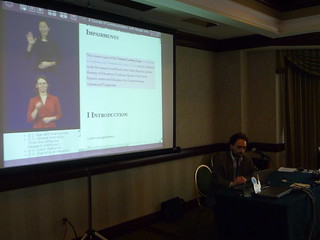 CSUN 13 presentation on Hybridbook, which was lead by my colleague Svatoslav Ondra from The Support Centre for Students with Special Needs, Masaryk University, Brno, took place on Friday.
CSUN 13 presentation on Hybridbook, which was lead by my colleague Svatoslav Ondra from The Support Centre for Students with Special Needs, Masaryk University, Brno, took place on Friday.
Hybrid Book provides a universal access to content for users with various disabilities as well as for users without disabilities, synchronizing audio, video, text media.
- Hybridbook is a digital publication format and also a couple of applications to read and author
- Its aim is to provide access to the content for readers with a limited perception of some of the information channel (e.g. the blind, the deaf, dyslexics and others)
- Hybridbook provides content in different types of media and ensure also their synchronization.
- Hybridbook 1: multimedia publication combining an electronic text with audio (made by human voice) supplemented by complex navigation apparatus. It must be read on computer, Hybrid Book Player is a native application, distributed on CD. This version was intended especially for people with visual impairement.
- Hybridbook 2: issued 2006, reader application migrated to online web app (because of easier maintenance). This version was based on HTML, JavaScript, Windows Media Player/QuickTime and also kept all functionalities and principles as well as synchronization with virtual cursors of screen-readers.
- HybridBook 3. Aim: present information with complementing records in the least possibly distorted form which enables:
- perceiving visual text visually
- perceiving text in Braille
- perceiving via sound recording
- perceiving in different languages (mainly in sign languages)
- Types of media: text, audio, video (mostly for sign language translations).
- More sources of the same media type - all synchronized, played at the same time or alternately.
- Incorporation of more complex objects (tabelar data, structured alternate form of graphics, mathematics expressions, footnotes).

- Primary target groups: blind and visually impaired users, deaf and hard of hearing users and users with learning deisabilities.
- There are two layers:
- Main layer (contains the main document (text, audio, video)
- Additional layer (contains extensional content to supplement insufficient information (can be hidden/shown, if shown it acts as a part of main layer)
- Media format:
- Text: XHTML
- Video: MPEG-4 (H.264), OGG (Theora codec)
- Audio: MPEG-1 Layer 3 (“MP3”), OGG (Vorbis codec)
- Synchronization:
- based on dividing content to synchronization units – the smallest building blocks (certain logically delimited passages)
- storage of synchronization data is independent on storage of document/media data
- Reading the book: there is full media synchronization, complex navigation and highlighting of the passage being currently read in text. User can also mute on/off audio or video track, switch among them or reposition UI components.
- Hybrid Book Authoring Tool: automatic division into synchronization units, creation of all meta data and scenarios for multimedia preparation and import/export Daisy 3.
- Near future: web app for mobile platforms, native mobile app and possibility to read documents offline.
- Future prospects: improvement of additional layers which provides alternate content of complex objects, implementation of “native” navigation in tabular structures and implementation of math expressions.
- Online version is on www.teiresias.muni.cz/en

1 komentář:
To jeden z fajniejszych blogów na blogspocie.
Okomentovat